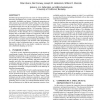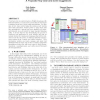CIDR
2011
13 years 9 months ago
2011
Organizations like the Internet Archive have been capturing Web contents over decades, building up huge repositories of time-versioned pages. The timestamp annotations and the she...
CIDR
2011
13 years 9 months ago
2011
Hyder supports reads and writes on indexed records within classical multi-step transactions. It is designed to run on a cluster of servers that have shared access to a large pool ...
143
click to vote
CIDR
2011
13 years 9 months ago
2011
Structured query language (SQL) is a classical way to access relational databases. Although SQL is powerful to query relational databases, it is rather hard for inexperienced user...
CIDR
2011
13 years 9 months ago
2011
A stream warehouse is a Data Stream Management System (DSMS) that stores a very long history, e.g. years or decades; or equivalently a data warehouse that is continuously loaded. ...
CIDR
2011
13 years 9 months ago
2011
Phase change memory (PCM) is an emerging memory technology with many attractive features: it is non-volatile, byte-addressable, 2–4X denser than DRAM, and orders of magnitude be...
CIDR
2011
13 years 9 months ago
2011
Distributed programming has become a topic of widespread interest, and many programmers now wrestle with tradeoffs between data consistency, availability and latency. Distributed...
113
click to vote
CIDR
2011
13 years 9 months ago
2011
If you have ever encountered a piece of highly domain-specific business software, you may have noticed that it was largely a graphical front-end to some relational database. You ...
CIDR
2011
13 years 9 months ago
2011
Data state in a data management system such as a database is the result of the transactions performed on that data management system. Approaches such as single-message transaction...
CIDR
2011
13 years 9 months ago
2011
Data management is becoming increasingly social. We observe a new form of information in such collaborative scenarios, where users contribute and reuse information, which resides ...
CIDR
2011
13 years 9 months ago
2011
This paper argues that next generation database management systems should incorporate a predictive model management component to effectively support both inward-facing application...



